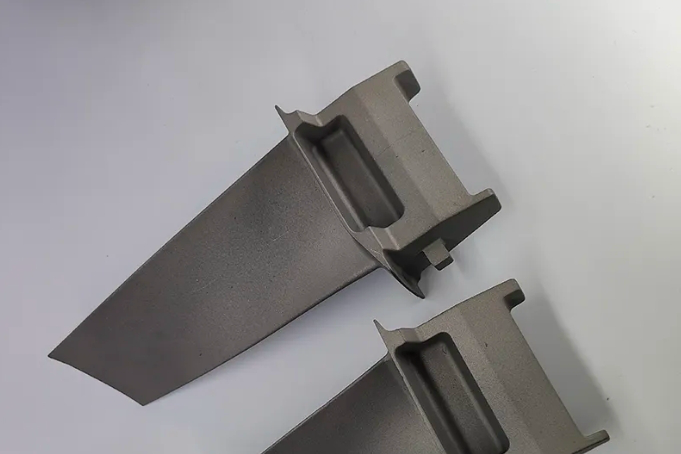Casting Superalloys CMSX-4 Turbine Blade Single Crystal Casting Manufacturer
Introduction
CMSX-4 is a second-generation nickel-based single crystal superalloy, engineered for superior high-temperature creep resistance, oxidation stability, and fatigue life. It is one of the most widely used materials for first-stage turbine blades. At Neway AeroTech, we specialize in single crystal casting services for CMSX alloys, producing CMSX-4 turbine blades with exceptional dimensional precision (±0.05 mm), defect-free single crystal structures, and outstanding high-temperature mechanical performance for aerospace and industrial gas turbines.
Using cutting-edge vacuum investment casting and directional solidification technology, Neway AeroTech delivers turbine blades capable of operating reliably at temperatures exceeding 1100°C.
Core Manufacturing Challenges for CMSX-4 Single Crystal Turbine Blades
Manufacturing CMSX-4 single crystal turbine blades presents several key technical challenges:
Achieving complete single crystal growth with precise <001> crystallographic orientation to eliminate grain boundaries.
Controlling withdrawal rates (~3–6 mm/min) and thermal gradients (~15–25°C/cm) to suppress stray grain and freckle formation.
Maintaining tight dimensional tolerances (±0.05 mm) on complex airfoil profiles and dovetail roots.
Managing residual stresses and avoiding crystallographic defects during solidification and cooling.
Single Crystal Casting Process for CMSX-4 Turbine Blades
Our highly controlled single crystal casting process includes:
Wax Pattern Fabrication: CNC-machined wax patterns replicating complex blade geometries with high precision.
Ceramic Shell Building: Application of multiple ceramic slurry and refractory layers to create durable molds capable of withstanding high temperatures.
Dewaxing and Shell Firing: Wax removal via autoclave at ~150°C and shell firing at ~1000°C for mechanical strength and thermal shock resistance.
Vacuum Melting and Pouring: CMSX-4 ingots melted under ultra-high vacuum (<0.01 Pa) to ensure chemical purity.
Seeded Single Crystal Growth: Mold withdrawal through a tightly controlled temperature gradient to promote <001> oriented single crystal formation.
Shell Removal and Post-Casting Heat Treatment: Removal of ceramic mold followed by solution heat treatment (~1260°C) and aging treatments to optimize γ' phase precipitation.
Precision CNC Finishing: Final machining achieving tolerances of ±0.01 mm and surface finishes of Ra ≤1.6 µm for critical aerodynamic and assembly surfaces.
Comparison of Manufacturing Methods for CMSX-4 Turbine Blades
Manufacturing Method | Dimensional Accuracy | Microstructure | Creep Resistance | Fatigue Resistance | Cost Efficiency |
|---|---|---|---|---|---|
Single Crystal Casting | ±0.05 mm | Single Crystal (<001>) | Superior | Superior | Medium-High |
Directional Solidification | ±0.05 mm | Columnar Grain | Excellent | Excellent | Medium |
Equiaxed Crystal Casting | ±0.1 mm | Equiaxed Grain | Good | Good | High |
Manufacturing Method Selection Strategy
Choosing the best manufacturing process depends on performance and application environment:
Single Crystal Casting: Essential for first-stage turbine blades and components subjected to the highest thermal and mechanical loads. Single crystal blades eliminate transverse grain boundaries, improving creep life and thermal fatigue resistance by 50% compared to equiaxed blades.
Directional Solidification: Suitable for intermediate turbine stages where high creep resistance is required but single crystal performance is not mandatory.
Equiaxed Crystal Casting: Adequate for stationary turbine vanes and lower-temperature stages.
CMSX-4 Performance Matrix
Property | Value | Notes |
|---|---|---|
Max Service Temperature (°C) | 1100+ | Sustained operation capability |
Tensile Strength (MPa) | 1100–1150 | High mechanical strength |
Creep Resistance | Superior | Outstanding at >1050°C |
Oxidation Resistance | Excellent | Minimal oxidation in hot gas paths |
Thermal Fatigue Resistance | Superior | No grain boundary failure risks |
Advantages of CMSX-4 Single Crystal Turbine Blades
Using CMSX-4 single crystal blades offers major performance benefits:
Superior Creep Life: Single crystal structure allows blades to operate at higher stresses and temperatures without significant deformation.
Outstanding Fatigue Resistance: Absence of grain boundaries prevents fatigue crack initiation during thermal cycling.
Enhanced High-Temperature Strength: Maintains mechanical properties beyond 1100°C in turbine hot sections.
Excellent Oxidation and Hot Corrosion Resistance: Enables long-term operation in aggressive combustion environments.
Key Post-processing Techniques
Critical post-processing ensures maximum blade performance:
Hot Isostatic Pressing (HIP): Improves density (>99.9%), eliminates microvoids, and enhances fatigue resistance.
Heat Treatment: Solution annealing (~1260°C) and multi-step aging to optimize γ' phase size and distribution.
Precision CNC Machining: Final trimming and polishing to achieve ±0.01 mm tolerances for critical fit and aerodynamic profiles.
Thermal Barrier Coating (TBC): Application of ceramic coatings to enhance oxidation resistance and thermal insulation.
Testing Methods and Quality Assurance
Neway AeroTech ensures every CMSX-4 blade undergoes aerospace-grade quality control:
Coordinate Measuring Machine (CMM): Dimensional inspection with ±0.005 mm precision.
X-ray Non-destructive Testing: Internal structure validation for stray grains and defects.
Metallographic Microscopy: Single crystal verification and phase distribution analysis.
Tensile and Creep Testing: Mechanical property validation under operational conditions.
All production processes are certified to AS9100 aerospace standards.
Case Study: CMSX-4 Single Crystal Turbine Blades for Aerospace Engines
Neway AeroTech successfully delivered CMSX-4 single crystal blades for a leading aerospace engine manufacturer:
Service Temperature: Continuous operation at 1100°C
Dimensional Precision: ±0.05 mm achieved across airfoil and root geometries
Mechanical Performance: Improved creep life by 50% over equiaxed blades
Certification: Fully compliant with AS9100 aerospace quality system
FAQs
Why is CMSX-4 an ideal material for single crystal turbine blades?
What are the advantages of single crystal casting compared to directional solidification?
What dimensional tolerances are achievable with CMSX-4 single crystal casting?
How does HIP improve the performance of single crystal turbine blades?
What quality control standards does Neway AeroTech follow for single crystal blade manufacturing?

